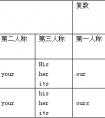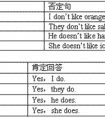用动词的适当形式填空1. He wants ________ (swim) in the pool.2. He likes _________(run ) in the morning.3. They often go _______( see ) an action movie.4. -七年级英语
(Cleaning the windows is your task.)
What I hate most is being laughed at. 我最痛恨的就是被别人嘲笑。
(Being laughed at is what I hate most.)
四、动名词作定语
动名词作定语往往表示被修饰词的某种用途。如:
a walking stick =a stick for walking=a stick which is used for walking
a washing machine=a machine for washing=a machine which is used for washing
a reading room=a room for reading=a room which is used for reading
a measuring tape=a tape for measuring=a tape which is used for measuring
sleeping pills=pills for sleeping=pills which is used for sleeping
动名词也有时态和语态的变化,如表所示(以及物动词write为例),不及物动词没有语态的变化。
| 时态、语态 | 主动 | 被动 |
| 一般式 | writing | being written |
| 完成式 having written |
having been written |
1) 动名词做主语时,谓语动词为单数
2) 在动名词和不定式中,作为介词的宾语是动名词
3) 动名词的否定直接在其前加否定词,通过代词的宾格或所有格形式给出逻辑主语
例:I would appreciate you calling back this afternoon.
4) 有些词后只能接动名词
acknowledge;admit; advise;advocate;allow;appreciate; avoid; celebrate; consider; contemplate; defer; delay; deny;
detest; discontinue; dislike; dispute; enjoy; it entails; escape; excuse; explain; fancy; feel like; finish; forgive; can’t help;
hinder; imagine; it involves; keep; it means; mention; mind; miss; it necessitates; pardon; postpone; practice; prevent;
recall; report; resent; resist; risk; suggest; understand...
5) 另外还有一些接-ing形式的常用说法
it’s no good; it’s no/little/hardly any/ use; it’s not/hardly/scarcely use; it’s worthwhile; spend money/time; there’s no;
there’s no point in; there’s nothing worse than; what’s the use/point
6) 有些词后面加不定式和动名词均可
remember,forget,try,stop,go on,continue,stop,regret,cease,mean后面均可用不定式和-ing形式,但意义截然不容。
例:remember to do/doing:
①I remembered to post the letters.(指未来/过去未来将要做的动作)
②I remembered posting/having posted the letters.(我记得做过这个动作)
forget与remember的用法类似。
regret的用法:
①I regret to inform you that…(我很遗憾地通知你……)
②I regretted having left the firm after twenty years.(为了“二十年前的离开”而遗憾。)
try to(努力)与try +–ing(试验):
①You really must try to overcome your shyness.
②Try practicing five hours a day.
考点名称:祈使句
- 祈使句:
表示请求或命令的句子是祈使句。祈使句一般用降调,为使祈使句听起来比较婉转,可用低声调,祈使句句末用句号或感叹号。
每种类型又有肯定形式和 祈使句的组成
①动词原形+其他
②Please+动词原形+其他
③否定形式:don‘t+动词原形,用don’t否定时,只能用其缩略形式。
例如:
Welcome to Beijing Park.
Walk about three blocks.
Don’t mention it.
<?xml:namespace prefix = "o" ns = "urn:schemas-microsoft-com:office:office" />
祈使句的含义:
1. 表请求
Pass me the sugar, please. 请把糖递给我。2. 表命令
Put up your hands. 举手。
Fill in this form. 把这个表填好。3. 表建议
Let’s have dinner together. 我们共进晚餐吧。4. 表邀请
Come in and have a seat. 进来请坐。
Help yourself to some fruits. 请吃水果。5. 表警告
Hurry up or you will be late.抓紧点,不然你要迟到了。
Do that again and you”ll be in trouble.要是再干那事,你会有麻烦的。6. 表禁止
Don’t touch the exhibits.不要触摸展品。
Don’t play on the road.不要在马路上玩耍。7. 表叮嘱
Be sure to get there before nine. 务必在九点前赶到那里。
Take care not to catch cold. 小心别着凉了。8. 表号召
Workers of all countries, unite! 全世界工人阶级联合起来!9. 表祝愿
Have a good trip. 祝你旅途愉快。 祈使句有三种类型:
一、含第二人称主语的祈使句
1. 当祈使的对象是第二人称you时称为含第二人称主语的祈使句。
这时,主语you通常不出现在句中,谓语动词用原形。
有时在句首或句末加please,还可加上称呼语,用逗号与句子主体隔开。如:
Please be quiet, boys! 孩子们,请安静!
Come this way, please. 请走这边。
如要加强语气,可在动词前加do。如:
Do keep away from the fire! 切记远离火种!
2. 否定式在谓语动词前加Don’t或Do not,强调否定式则在动词前加Never。如:
Don’t alway make the same mistake. 不要老犯同一个错误。
Never be late again. 千万别再迟到了。
3. 有时,为了强调指明向谁提出要求或发出命令,或表达说话人的急躁、厌烦、不满、恼怒的情绪,就用主语you表示,且放在动词前。如:
You come here! 你到这里来!
You mind your head! 小心别碰到头了!
若为否定式,则把Don’t放在主语you之前。如:
Don’t you come here! 你别来这里!
二、含第一、第三人称主语的祈使句
1. 含第一或第三人称主语的祈使句通常以Let开头,
第一人称由“Let + me / us +动词原形”构成,
第三人称由“Let + 第三人称代词(用宾格)或名词+动词原形”构成。
这类祈使句往往用于提出建议。如:
Let me have a try if you don’t want to. 如果你不想,就让我试一试吧。
Let’s spend this weekend in the country. 咱们到乡下去度这个周末吧。
Let him be here by ten o’clock. 叫他10点到这里吧。
有时也可以先称呼对方的名字,,后跟一句无人称主语的祈使句。如:
Jane, sit down please. 简,请坐下。
Mum, remember to bring me an umbrella. 妈妈,记得给我带把伞。
2. 这类祈使句的否定式是在动词原形前加not,也可以在let前加Don’t。如:
- 最新内容
- 相关内容
- 网友推荐
- 图文推荐
| [家长教育] 孩子为什么会和父母感情疏离? (2019-07-14) |
| [教师分享] 给远方姐姐的一封信 (2018-11-07) |
| [教师分享] 伸缩门 (2018-11-07) |
| [教师分享] 回家乡 (2018-11-07) |
| [教师分享] 是风味也是人间 (2018-11-07) |
| [教师分享] 一句格言的启示 (2018-11-07) |
| [教师分享] 无规矩不成方圆 (2018-11-07) |
| [教师分享] 第十届全国教育名家论坛有感(二) (2018-11-07) |
| [教师分享] 贪玩的小狗 (2018-11-07) |
| [教师分享] 未命名文章 (2018-11-07) |


![Sunday is my birthday. I would like _____ a birthday party, would you _____to my party? [ ]A. have; come B. to have; to come C. have; to come D. to have-七年级英语](http://www.00-edu.com/d/file/ks/4/2/budingshi/2020-01-08/smalla85122db0c71d7fb6ae58187be7f1fd11578430330.png)

![Why areyou here? You are supposed ______ in the classroom now. [ ] A. to studyB. to be studiedC. studying D. to be studying -九年级英语](http://www.00-edu.com/d/file/ks/4/2/budingshi/2020-01-08/small6dee02daa62cac1c71853ac804ab4fbd1578422460.png)
![She is very poor. Little food _____ and no room _____! [ ]A. to eat, to live B. to eat, to live in C. eating, living -八年级英语](http://www.00-edu.com/d/file/ks/4/2/budingshi/2020-01-09/small17b77c2697a3ef8f1461d0d14b016ee51578585185.png)


